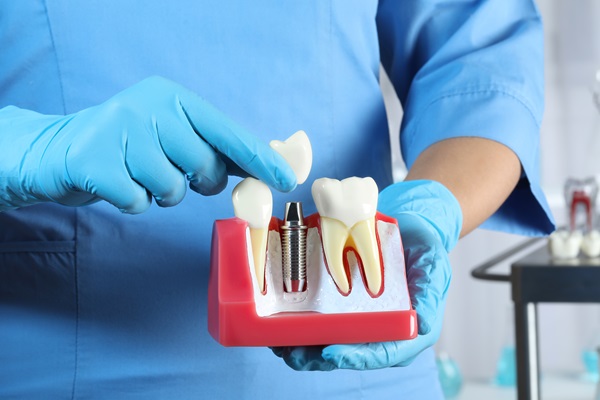When a Bone Graft for Dental Implant Restoration May Be Recommended

A bone graft for dental implant restoration may be recommended by a dental professional to restore the density inside of the jawbone. This should take place before the placement of dental implants if the patient has lost density in their jawbone due to atrophy following tooth loss or as a result of periodontal disease.
A discussion of bone grafting before dental implant restoration
Although needing a bone graft before beginning the dental implant restoration process is not good news, there are benefits that the procedure provides. By understanding why a bone graft may be necessary and what the benefits of the procedure are for your oral health and dental implant restoration long-term, you can help alleviate any nerves you may have beforehand.
A bone graft procedure for dental implant restoration explained
A dental bone graft procedure, also called a bone regeneration procedure, is a part of the dental implant restoration process for many patients. Specifically, the procedure is necessary if the patient has lost bone inside of the jaw. When this occurs, it can lead to a sunken jaw look and makes implant failure more likely. A bone regeneration procedure restores the health and appearance of the jaw.
The bone graft procedure process
A bone graft involves taking bone from another part of the jaw or body and grafting it where the bone loss occurred, which is usually above or below where a tooth is missing. An incision is made into the gums to access the jawbone, and the new bone material is grafted into place. The procedure is considered a form of oral surgery, so sedation is used to help ensure the procedure is painless.
How long does recovery take after a bone graft?
A bone graft only takes one dental visit, and the patient can return home on the same day. Most patients see any post-surgery discomfort go away within a week or two, but it can take longer for the regeneration process to happen. Once the bone has healed, which typically takes several months, the dental implant placement procedure is scheduled.
What to expect after a bone graft
Many patients report feeling as if their jawbone is fuller after the procedure, especially if the bone loss was relatively severe. The placement of the dental implant (or multiple implants) is scheduled once the jawbone heals. This procedure involves minor surgery as well. After the implant fuses with the new jawbone, then the restoration is placed to complete the process, and the patient can enjoy their new and improved smile for years to come.
FAQs: bone graft for dental implant restoration
It is helpful to have all of your questions answered before the procedure to help alleviate any anxieties you may have. The following are several questions about bone grafting before dental implant restoration, including whether or not it is necessary and the different types of bone grafts.
Are bone grafts required before dental implants?
As discussed, a bone graft is not required in all cases of dental implant restoration. Instead, it is typically recommended for patients that have lost bone inside of the jaw due to atrophy or periodontal disease. If the patient has not experienced significant bone loss inside of the jaw, then they can most likely proceed with the placement of dental implants and forego a bone graft procedure.
What are the different types of bone grafts?
An autograft is perhaps the most common type of bone graft when preparing for a bone graft. This involves the removal of bone tissue from other areas of the mouth (e.g. the hard palate or chin). In some cases, bone is taken from the hip or shin. Other types of bone grafts that may be available include an allograft, which uses donor tissue from another person, and a xenograft, which takes donor tissue from an animal (usually a cow or pig). An alloplast procedure may also be an option as well, which is donor tissue that is created from minerals and other natural sources.
Find a long-term teeth replacement solution with a dental implant restoration
A dental implant restoration allows you to replace one or more missing teeth in a manner that feels, functions, and looks natural. Here at our practice, we take genuine pride in seeing our patients achieve a new smile with dental implant restoration that restores their confidence and oral health. To get started, give us a call or send us a message for a prompt reply.
Request an appointment here: https://www.johnscreekteeth.com or call Johns Creek Dentistry at (770) 623-1427 for an appointment in our Johns Creek office.
Check out what others are saying about our dental services on Yelp: Dental Implant Restoration in Johns Creek, GA.
Recent Posts
Restorative dentistry is the process of restoring damaged or missing teeth. You have had a form of dental restoration if you have ever had bridges, crowns, or fillings. Dentists want to improve or maintain your smile while preventing future dental complications. Restorative procedures need care and attention to detail. Therefore, only qualified dental professionals should…
What can a restorative dentist do for patients? This is a big question with a lengthy answer. However, in a nutshell, restorative dentistry may be a good fit for many people.Patients should consider if they have problems with their teeth or if their teeth feels loose, wobbly, or if they get cavities easily. Restorative dentistry…
The goal of restorative dentistry is to repair a smile that is damaged to achieve optimal oral health, appearance, and function. This review discusses restorative dentistry and highlights the various services that this branch of dentistry includes.Learning more about the benefits of restorative dental services can help you determine how a restorative dentistry visit can…
A lot of people suffer from having crooked teeth; thankfully, there are a few teeth straightening methods that can fix crookedness. Dentists have been providing teeth straightening treatments to people of all ages for decades; however, there are still a lot of myths associated with the process. Considering teeth straightening to improve your smile? It is…


